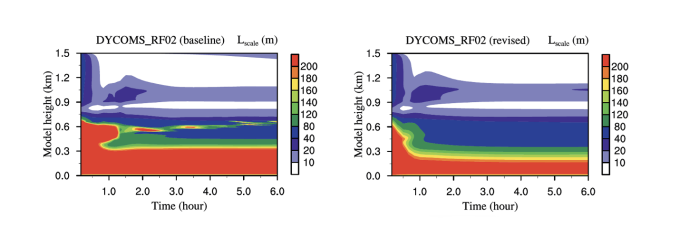Disclaimer: This article is more than two years old. Developments in science and computing happen quickly, and more up-to-date resources on this topic may be available.
Cloud Layers Unified By Binormals (CLUBB) is a commonly used model of clouds and turbulence—including by the Department of Energy and the National Center for Atmospheric Research.
In certain cases, however, the mathematical choices an atmospheric scientist makes using CLUBB can lead to small, nonphysical wibbles and wobbles at higher resolution. This hasn’t caused problems in the past, but as computing power continues to improve, CLUBB’s resolution becomes more refined, and the noise that was hidden before can get exposed.
To help avoid potential issues, a team of researchers, including LLNL computational mathematicians Chris Vogl and Carol Woodward, introduced modifications to CLUBB that minimize these effects.
A Timely Necessity
Until recently, the typical spatial resolution for weather models was a square of about 100 kilometers-by-100 kilometers.
“For a lot of cloud regimes, that’s sufficient. If you have an overcast day, you can describe that in 100 kilometer-by-100 kilometer blocks, but if you want to talk about a cumulonimbus cloud—a big storm cloud—it’s not 100 kilometers wide,” explains Vogl. In fact, it can be much smaller. “Now, we’re starting to capture that with better computational resolution.”
Accommodating this variability has a caveat, though. With improved resolution, the wiggles and wobbles become significant, and they don’t seem to correspond with any real physical phenomena.
Easy Fixes, Important Impacts
From a mathematical perspective, the fixes to these nonphysical puzzles weren’t particularly complicated to develop.
“The math that we applied is not Earth-shattering math. It’s bringing in the right math in the right place,” says Woodward.
For one, the team improved what’s known as “artificial diffusion” in the model—which, despite its name, is a real feature describing molecules moving past each other in the atmosphere and spreading apart. But its nuances make it complicated to represent mathematically—for example, some storms may have a sharp storm front, which artificial diffusion inadvertently softens out. To address this, the researchers replaced the artificial diffusion expression with a more straightforward representation, better capturing the clouds’ physical behavior in a computationally efficient way. They also smoothed out discontinuities in the equations that were leading to nonphysical oscillations in the solutions.
They tested the revised model on four cloud cases: one stratocumulus—the type of fluffy, low-level cloud commonly seen in the sky; two shallow-cumulus cases—calm clouds in ocean winds; and one dry turbulence case.
And the revisions worked. The updated model does not manifest the nonphysical solutions seen previously, and the solutions are better behaved numerically.
The team—a collaboration between Pacific Northwest National Laboratory, LLNL, the University of Wisconsin-Milwaukee, and Blue River Technology—has plans to continue improving CLUBB. The project is part of the Department of Energy’s Scientific Discovery through Advanced Computing (SciDAC) program, which fosters relationships between science offices and mathematicians in scientific computing.
—Anashe Bandari


